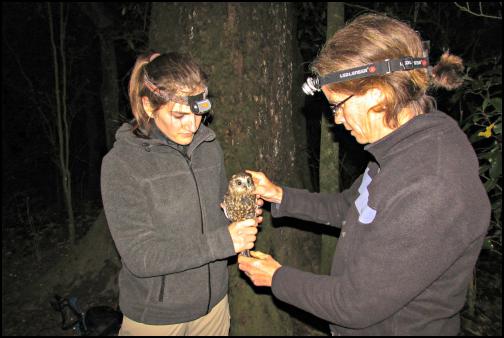Bid to protect morepork on Banks Peninsula

Carina Pohnke (left) and DoC science advisor Moira Pryde hold a female morepork that was caught by DoC in Kaituna Valley last year. A transmitter was attached to the bird and will stay in place for 18 months so the morepork’s home range can be tracked over time.
16 March
- for immediate release
Bid to protect morepork on Banks Peninsula
A Lincoln University student has been involved in a project that aims to conserve vulnerable morepork on Banks Peninsula, as well as enhance their breeding potential.
As part of a 10-week summer research scholarship, Carina Pohnke spent time searching the peninsula for signs of these small, forest-dwelling owls so she could map their distribution. Now she is in the process of documenting her findings.
“Morepork are not nationally endangered, but they’re less common on Banks Peninsula than in other areas,” says Carina, a third-year Environmental Management and Planning student.
“This is due to changes in their preferred habitat and being targeted by predators like rats, stoats and possums. Morepork lay their eggs in tree holes and holes in the ground, which means predators can get to them easily.”
To address this problem, the Banks Peninsula Trust has initiated a project with the Department of Conservation (DoC) to identify morepork habitats, with the ultimate aim of increasing the birds’ survival and breeding success in the area.
Carina applied for the research scholarship in 2014, towards the end of her second year of study. Lincoln University’s Faculty of Agriculture and Life Sciences was offering a number of summer scholarships to students who were intending to study full-time this year.
“I listed three different projects I would like to work on, and the morepork one was my first choice, so I was really pleased to get that,” she says.
“A lot of the projects focused on invertebrates, but I’m more interested in bigger animals. I grew up in Germany, and had never heard of morepork, so I was really keen to work with them.
“The scholarship gave me an opportunity to work in a research environment and gain valuable research skills.”
Carina’s involvement in the morepork project had her working with Banks Peninsula Trust volunteer Alison Evans and DoC science advisor Moira Pryde.
“We went to 27 different DoC reserve sites and set up acoustic monitors to record morepork calls,” she says.
“DoC had started up the programme the previous summer and made a list of sites they thought we should use. We could set the time, date and period of the recording on the acoustic monitors.
“Because morepork are nocturnal, recordings were set to take place between 6pm and 6am.”
The monitors would be left in particular areas for seven-to-10 nights, then were collected and analysed on a software program called Freebird.
The Banks Peninsula Trust also enlisted locals to report on morepork sights and sounds near their homes, publicising the project as ‘Morepork Monday’.
“People were asked to spend an hour on Monday evenings listening for morepork calls,” Carina says.
Based on the acoustic monitor findings, as well local reports, Carina produced a map of morepork distribution on the peninsula.
“The people who took part in ‘Morepork Monday’ generally lived in more populated areas, and combining those findings with what was found with acoustic monitors at the much more remote DoC reserves gave us some pretty clear patterns of where the birds are located,” Carina says.
The Banks Peninsula Trust now aims to put nesting boxes into the sites where morepork habitats have been identified, in order to provide protection for the birds.
“I helped to gather baseline data, and now nesting boxes will be sent out to the locations where we have found morepork,” Carina says.
“The trust is also keen to get schools involved with the project.”
Ends


 Vegetables New Zealand: Asparagus Season In Full Flight: Get It While You Still Can
Vegetables New Zealand: Asparagus Season In Full Flight: Get It While You Still Can  Bill Bennett: Download Weekly - How would NZ telecoms cope with another cyclone
Bill Bennett: Download Weekly - How would NZ telecoms cope with another cyclone NZ On Air: Firm Audience Favourites Lead NZ On Air Non-Fiction Funding
NZ On Air: Firm Audience Favourites Lead NZ On Air Non-Fiction Funding Insurance and Financial Services Ombudsman: Woman Gets $40k More After Disputing Insurer’s Decision
Insurance and Financial Services Ombudsman: Woman Gets $40k More After Disputing Insurer’s Decision BNZ: A Quarter Of Older NZers Fear Going Online Due To Scam Concerns
BNZ: A Quarter Of Older NZers Fear Going Online Due To Scam Concerns University of Auckland: Scientists Develop Tool To Monitor Coastal Erosion In Fine Detail
University of Auckland: Scientists Develop Tool To Monitor Coastal Erosion In Fine Detail



